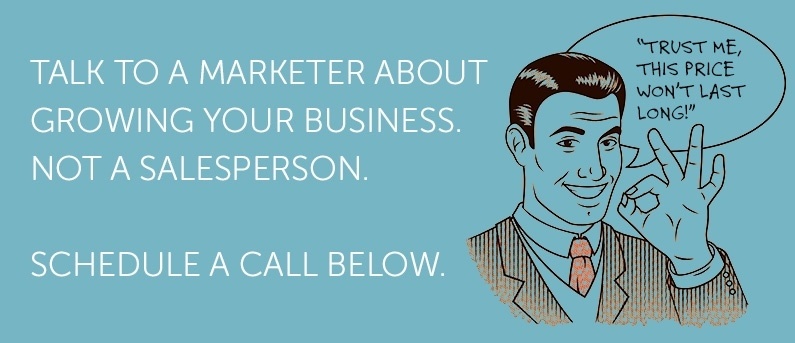
Imagine your ideal customer.
Now do that several times over, and you’re on your way to creating your very own marketing personas.
If you're not familiar with the term, marketing personas are detailed and robust combinations of demographics, buying habits and behaviors of your company's ideal customers. They speak to the needs and pain points your customers have, giving you insights into what they care about the most. They tell you what customers do in their free time, and even who their family is and what core values they hold.
Literally, everything.
In other words, they represent all aspects of your ideal customer and what motivates them to buy. They're as close to the real thing as you can get.
As a digital marketing company, we can attest to how important these personas are to developing a marketing and content strategy. They help you and your marketing team understand your business and its customers in a more realistic and personal way.
You're putting a name (and sometimes a face) to Customer X.
There are two things to understand about marketing personas:
- You probably have more than one. You will likely create more than one marketing persona because your customer base is varied. And, because you have different marketing personas, that means your content is not one-size-fits-all. Content that resonates with one persona won’t have the same effect on another.
- Multiple personas means better organization. Having more than one marketing persona brings order and focus, not confusion. By knowing what kind of content interests each persona, you can organize and structure your content marketing efforts in a targeted way that gets results. Naturally, this tends to work better than throwing broadly based content out there and hoping something sticks.
Align Content To Marketing Personas
Targeted content. That’s your ultimate goal as a content marketer, isn’t it? You want content that hits the bullseye.
But, you can only create targeted content if you have a target in mind - your persona.
Connect content to your customer’s pain points
One of the key steps of creating personas is identifying customer pain points. What do they need solved? What's bothering them? It’s that “pain” that sends them looking for a solution to buy.
Create content that speaks directly to the pain point. By doing some keyword research, you can see what your targets are searching relative to that topic. When customers search online for an answer to their problem using the keyword(s) you've targeted, your content will show up in their results.
This is where detailed personas can help. Your personas pain point is probably not, “I need software to make my job easier,” but rather, “I need software that makes my accounting job easier, isn't difficult to use and my company can afford.” The more you know about the pain points, the more your content is actually useful and not mere shallow “sales talk.”
Connect content to the buyer's journey of each persona
For marketers, understanding the buyer’s journey is crucial. You should create content that can speak to customers who might be at different points on their journey.
- Awareness: The customer knows they have a need.
- Consideration: The customer finds your content and determines if your product or service meets their need.
- Decision: The customer is ready to buy from you.
The content you create for the buyer's journey should address each of these three stages per persona. As mentioned before, each persona's journey will look different because their motivations, needs, values, etc. are not the same.
Consider what kind of information each persona requires before they can move from one stage to the next, and how they'd prefer for it to be delivered. For example, some personas may move through the stages quicker than others and not need a lot of coaxing to get to the point of purchase. Perhaps a few informative videos would be sufficient for them. More tentative personas might require something that builds proof over time, like an entire series of various forms of content.
Content must fit the persona as it fits into the buying journey.
Create A Campaign Around Personas
A persona-based content campaign is a targeted effort to get a persona through the entire buyer’s journey. To do that successfully, you need to be purposeful, both in how you target your persona and how you structure the content you release.
Segment your contact list into personas
As a whole, your contact list isn’t useful for creating targeted campaigns. Your contacts may be valid leads, but they all engage with your company differently. By segmenting (dividing and grouping) your contacts, you end up with the ability to target content more precisely and effectively.
Of course, this process can involve more than segmenting it into personas. You can segment further by where they are in the buyer’s journey, basic demographics, past purchases, industry, age - whatever makes sense for your business. However you do it, though, this should be done before you move onto your next step.
Determine a trigger event
There are certain events that are going to trigger your persona to start looking for a solution. Each persona will have different triggers, but you need to identify what they could be and create content that answers each one specifically.
The trigger might be the loss of job, or a career change. Look at your personas and determine what might set them on a path towards buying your product or service. Determine what keywords to associate with this trigger and be smart about it - you’ll be using them heavily when you create your content.
No, this trigger content isn't broad, general content. It might not seem terribly “evergreen.” Instead, it is the beginning of a targeted campaign that will actually lead to a sale.
Decide on the campaign’s building blocks
Content campaigns can be made up of emails, blog posts, infographics and other forms, so you'll need to decide which elements you’ll use to build your campaign.
The next step is to plan out how those building blocks will be used. For example, you might use lead forms to gather emails. Or, you might offer a free download in the middle of an informative blog post to move the visitor closer to a sale by first committing to the download.
Again, each persona requires a different approach. Various components of the campaign will make more sense for some personas than for others. The content shouldn't just be tailored - the whole campaign should be.
Determine what content properties you’ll use
You have several content properties you can use in your persona-based campaign. You have owned properties (your blog and website), paid properties (ads, remarketing) and earned properties (customers and social media fans who share your content willingly).
You might use them all in some form in your personas' campaigns. Also consider that the properties can address personas in several stages of their buyer's journey. Once you've outlined your campaign, you'll be able to discern which property fits which persona at which stage.
The content you offer with each property will vary, too. For example, blog posts aren't just for Persona A in the awareness stage. Assuming your blog topics are guided by your keyword research, you could just as easily create posts that speak to Persona B's decision stage.
Get creative with your content, but make sure you're able to back it up with strategy, research, and data. There should always be a method to your madness.
And if you get lost in your research and planning, don't be afraid to talk to a team of marketing professionals. It's crucial to get this part right! Bad strategy here could not only cost you leads, but also time and money. A good content strategy, on the other hand, will help your business run and grow as smoothly as possible, with purpose.

